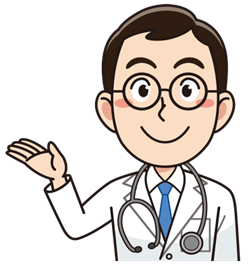ILC's Treatment for Spinal Stenosis
The "Cellgel Method" for Intervertebral disc repair and regeneration &
The "Florence Method", an advanced outpatient treatment for spinal canal stenosis
Are both now available in Japan!
For those who have been told it was impossible to operate,
For those who have had recurrence of pain post-surgery,
low-risk, outpatient treatments are now an option for you.
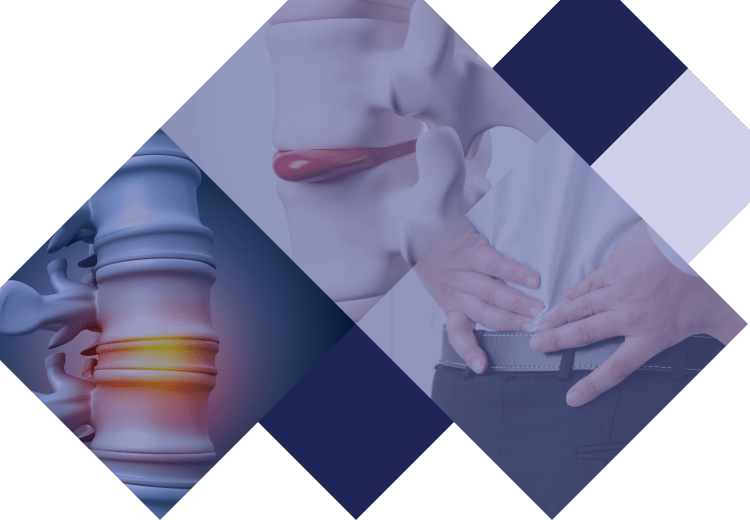
Contents
 Table of Contents
Table of Contents
This page provides information on the main symptoms and causes of spinal stenosis and our treatment procedures. The information includes the method of treatment, treatment time, and information about insurance. We use the Cellgel method, which is one of the most advanced methods in the world, and the characteristics of this method are also described in detail.
Please read this page especially if you have been told that you cannot be cured without surgery, if you have had surgery in the past but have not improved, or if you got better after surgery but the symptoms have recurred.
What is spinal stenosis?
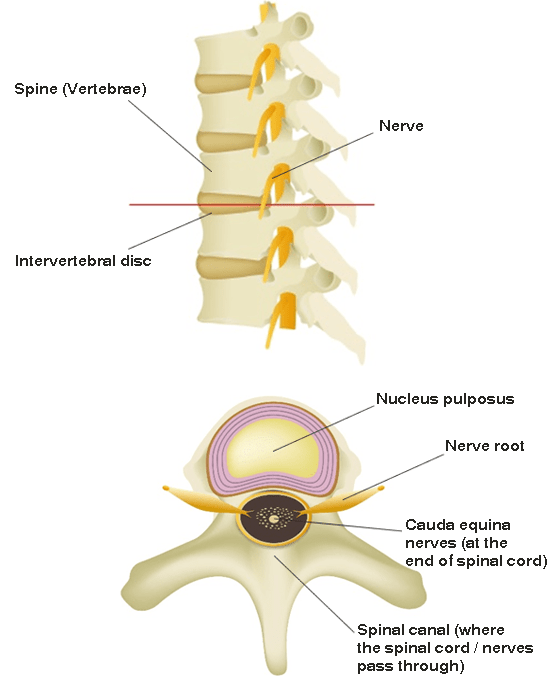
Spinal stenosis refers to a narrowing of the spinal canal in the spine.
As shown in the figure, the spine is largely composed of (1) bones, (2) intervertebral discs, and (3) nerves. The path where the spinal cord passes through is located in the center of the spine and is called the spinal canal.
Spinal canal stenosis refers to a condition in which the spinal canal becomes narrowed, resulting in nerve compression. In particular, the term "lumbar spinal canal stenosis" refers to a disease in which the spinal canal narrows in the lumbar region.
Lumbar spinal canal stenosis" is often caused by instability of the lumbar vertebrae, which often results in pain with physical movement. As shown in the figure below, there are three types of spinal canal stenosis: (1) foraminal stenosis, (2) cauda equina syndrome, and (3) mixed stenosis.
Foraminal stenosis is relatively easy to heal and is often treated with conservative therapy (drugs, rehabilitation, etc.). It is known that in many cases, the symptoms of cauda equina syndrome and mixed stenosis do not improve without surgical procedures. Lumbar spinal canal stenosis is often caused by instability of the lumbar vertebrae, which often results in pain with physical movement.
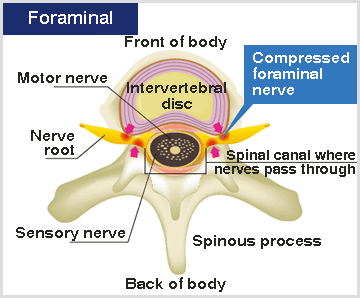
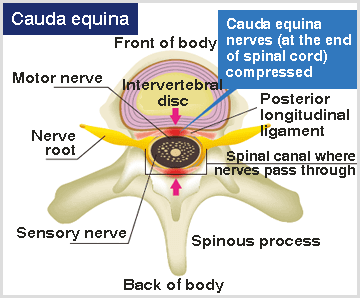
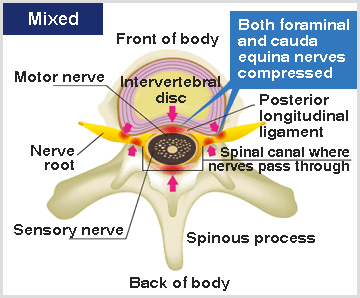
Main symptoms of spinal stenosis
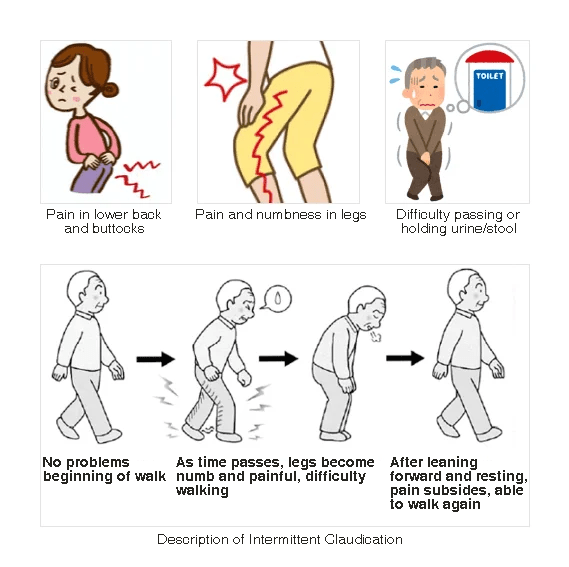
Spinal canal stenosis is a disease that often develops in the cervical or lumbar spine. When the disease occurs in the cervical spine, patients may experience numbness and motor problems in the limbs. For example, in addition to upper limb (arms and hands) symptoms such as difficulty using chopsticks, writing, and buttoning, lower limb symptoms such as difficulty walking, general unsteadiness, and climbing stairs may also occur.
With lumbar spinal stenosis, numbness and pain appear from the waist down. When walking, one feels pain or numbness in the buttocks or legs, which eases after a rest. These symptoms are characteristic of a condition called intermittent claudication.
In addition, lumbar spinal stenosis does not cause severe back pain, and symptoms are not aggravated when at rest. Howevr, standing or walking with a straight back may cause numbness and pain in the thighs and below the knees, making it difficult to walk.
Causes of spinal stenosis
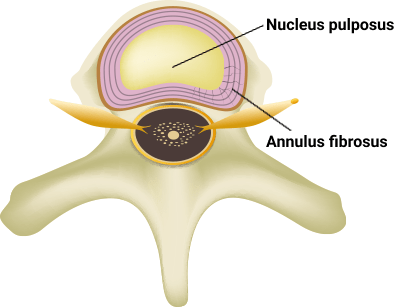
Cracks in the fibrous rings (annulus fibrosus) of the intervertebral disc
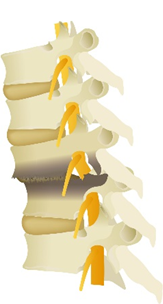
Discs are collapsed, bone is misaligned, and nerves are compressed.
Difficulty in walking, pain and numbness in the thighs, pain while walking then being able to walk again after a break, pain in the lower back when stretching the back, pain when standing up, difficulty in getting up from bed, pain affecting daily life - Spinal stenosis is characterized by a number of symptoms, many of which are likely to come from the nerves.
There are several possible causes of these nerve-compressing symptoms, and in recent years the causes have become clearer.
Recent research has revealed that "damage to the disc is involved in one of the root causes." The reasons for this are described below:
Chronic back pain does not appear in childhood because the cushioning discs, bones, and nerves are undamaged and function normally. However, the spinal canal becomes narrower as we age, misalignment of the spine (e.g., slipping), and herniated discs also compress the spinal canal, resulting in stenosis.
As early as around 16 years of age, the lower back is found to be carrying the most stress, and damage (cracks) begin to occur in the intervertebral discs. The nucleus pulposus, which is the source of the cushioning of the spine, leaks from the damaged area, and the intervertebral disc itself decreases in size and its cushioning function declines. As the cushioning function decreases, the bone is overloaded and begins to deform. As the bones become deformed, the spinal canal, the space where the nerves reside, eventually narrows and begins to compress the nerves.
In other words, it is now known that spinal canal stenosis begins with damage to the intervertebral discs. In addition, spinal canal stenosis can cause a condition called intermittent claudication, in which the patient's legs become numb when walking, but is able to walk again after a short rest.

Cracks in the fibrous rings (annulus fibrosus) of the intervertebral disc

Discs are collapsed, bone is misaligned, and nerves are compressed.
Why is the recurrence rate so high?
Spinal canal stenosis occurs when a compressed intervertebral disc (part of the layer called the annulus fibrosus) cracks, causing the central portion to protrude, and the protruding portion (herniated disc) narrows the spinal canal.
Conventional surgical methods relieve symptoms by removing the herniated disc that has protruded, but since the cracks in the disc are not repaired, the disc may herniate again.
This is the main cause of recurrence, which is why it is said to be a disease that is difficult to cure completely.
The Cellgel method used at our clinic injects a drug that fills the cracks in the disc, which then forms a gel that replaces the cracks, thereby providing a fundamental cure to the root cause.
Conventional Surgery
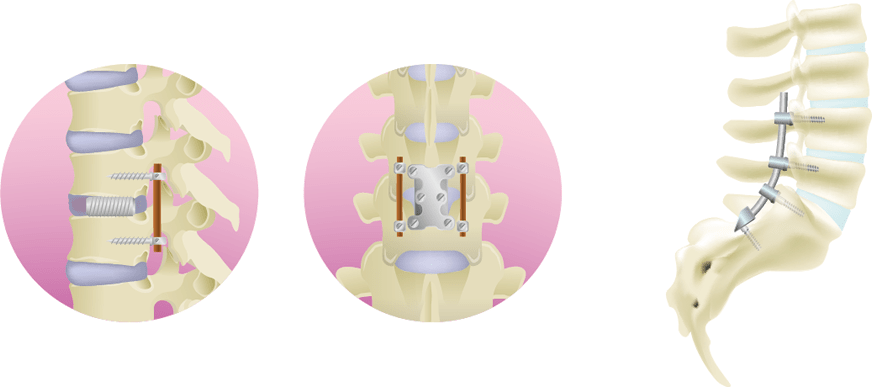

The removal of the bone and part of the disc that is compressing the spinal canal relieves pressure on the spinal canal, but the spine becomes unstable, so an artificial disc is inserted and the bone is secured with a metal device called a bolt and rod.
Cellgel Method
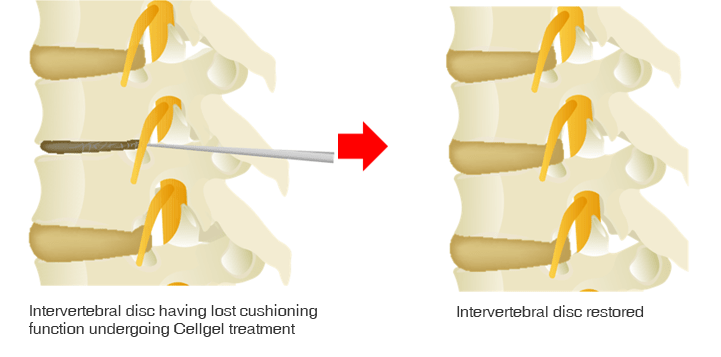
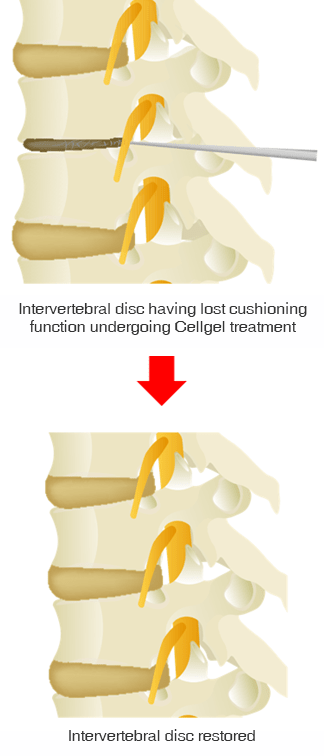
Since many of our patients come from far away,
we are happy to give free consultations to see which treatment is best for you
We'll diagnose your MRI images for free!
About our clinic's treatment methods
Our clinic has five treatment methods: Cellgel method, Florence method, hybrid laser method, PODD method, and PLDD method.
The five treatment methods have different features and benefits, but we would like to first introduce you to the "Cellgel method" , which is the only treatment that can "repair the intervertebral disc", and the "Florence method'', which can "widen the stenosis".
About Cellgel
The Cellgel method is an advanced treatment for low back pain that has been implemented in more than 54 countries worldwide, predominantly in Europe.
As with other treatments, it does not decrease the disc volume, and since the drug remains in the disc as a gel-like implant after treatment, the disc can be preserved. Recent studies have also shown that the volume of the disc increases after treatment.*1
It is also thought that by repairing the disc and preventing leakage of the Nucleus Pulposus, the disc itself will restore its normal function with its own regenerative ability (*2).
It is particularly recommended for patients who are concerned about the risk of conventional disc surgery (MED, PELD, etc.).
*1 Source: European Journal of Radiology 109 (2018) 101–107 , Efficiency of an ethyl alcohol gel in symptomatic disc hernation
*2 Source: International Journal of Spine Surgery Vol. 15 Appendix 1 from regenerative treatment of disc degeneration
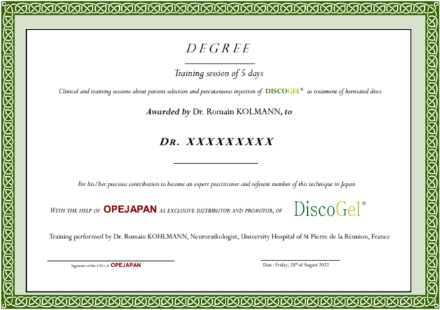
"Very good or good results were obtained in 202 (91.4%) of the 221 patients in group A. Of the 44 patients in group B, 37 patients (84%) presented very good or good results and in 9 (82%) of the 11 patients of group C, we obtained similar results. There was no allergic complication in any of our patients. Long-term follow-up magnetic resonance showed a dramatic reduction in hernia volume."
- Dr. J. Theron, one of the world's leading experts in the treatment of Celgel method, from his research article "Percutaneous Treatment of Lumbar Intervertebral Disk Hernias With Radiopaque Gelified Ethanol - A preliminary study."
Merits of Cellgel
- Possibility to repair intervertebral discs where unable to using surgical or laser treatment
- As the disc is repaired, the disc itself regains its original normal function through its own regenerative ability
- The Cellgel method uses local anesthesia over general anesthesia used in conventional surgery, making it less burdensome on the body
- Treatment is done with a thin needle, so the wound is minimal and recovery is rapid
- Treatment is very short, allowing for outpatient day treatment
- Safe, modern treatment proven in more than 54 countries around the world
Flow Cellgel Treatment Process
-
01 Examination

MRI and X-rays will be taken, followed by a doctor's diagnosis.
If the diagnosis proves the Cellgel method suitable, treatment can begin that same afternoon. -
02 Before
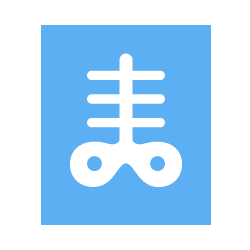
TreatmentAfter entering the treatment room and administering local anesthesia to the lower back, a needle is inserted into the intervertebral disc identified in the examination.
A contrast scan is performed to confirm the location of the damaged disc. -
03 Treatment
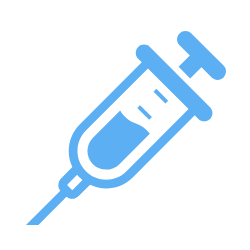
The Cellgel drug is administered to the damaged area while confirming the location of the disc with a fluoroscopy device.
Once the drug has been absorbed, the needle is removed and the bleeding is stopped.
-
04 Returning
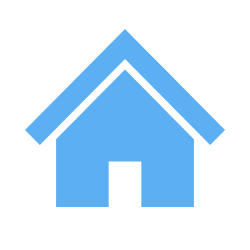
HomeAfter the treatment, the patient rests in a private room for about an hour, and then allowed to go home after the post-treatment examination.
*Resting time depends on the patient's symptoms and condition.
Price Cost of Treatment for the Cellgel Method
| Number of Discs Treated |
1 disc | 2 discs | 3 discs | 4 discs | 5 discs |
|---|---|---|---|---|---|
| Treatment Cost | 1,320,000 JPY | 1,430,000 JPY | 1,540,000 JPY | 1,650,000 JPY | 1,760,000 JPY |
Swipe left/righ
* The cost of treatment is indicated including taxes.
*If treatment is performed at our clinic, all examination/diagnosis costs and test costs such as MRI are included in the above costs.
*This treatment method is not covered by Japanese health insurance, so you will have to pay for the entire treatment yourself.
*Payment by credit card (VISA, MasterCard, JCB, American Express, Diners, Discover) is also possible.
*If you would like rehabilitation (low back pain specialized rehabilitation), it is also possible to pay by bank transfer.
*If you live and work in Japan, you can receive a tax refund by filing your final medical expense return.
What is the Florence method?
The Florence method is an advanced treatment for spinal canal stenosis that has been introduced mainly in Europe and South America.
Spinal stenosis is a condition in which the intervertebral discs degenerate, resulting in herniated discs, or when the vertebrae lose stability and slip, narrowing the spinal canal and putting pressure on the nerves. This causes symptoms such as lower back pain or pain and numbness in the lower limbs, making it difficult to walk.
Spinal canal stenosis is the most common spinal disease, according to the spine surgery survey report of the Japanese Society of Spine and Spinal Cord Disease. *1
It is particularly common among people over 50 years old, and one in two people over 70 years old may suffer from this disease. *2
*1 Reference source: Yutaka Nohara et al., “Spine Surgery Survey Report of the Japanese Society of Spinal and Spinal Cord Disease,” “Journal of the Japanese Society of Spine and Spinal Cord Disease,” Vol. 15, No. 2, 2004.
*2 Reference source: Ken Yamazaki, “Lumbar spinal stenosis treatment strategy: Epidemiological survey and QOL survey of lumbar spinal stenosis—Prevalence and health-related QOL survey of the general population in local cities,” “Monthly Book Orthopedics,” No. 23 No., 2010.
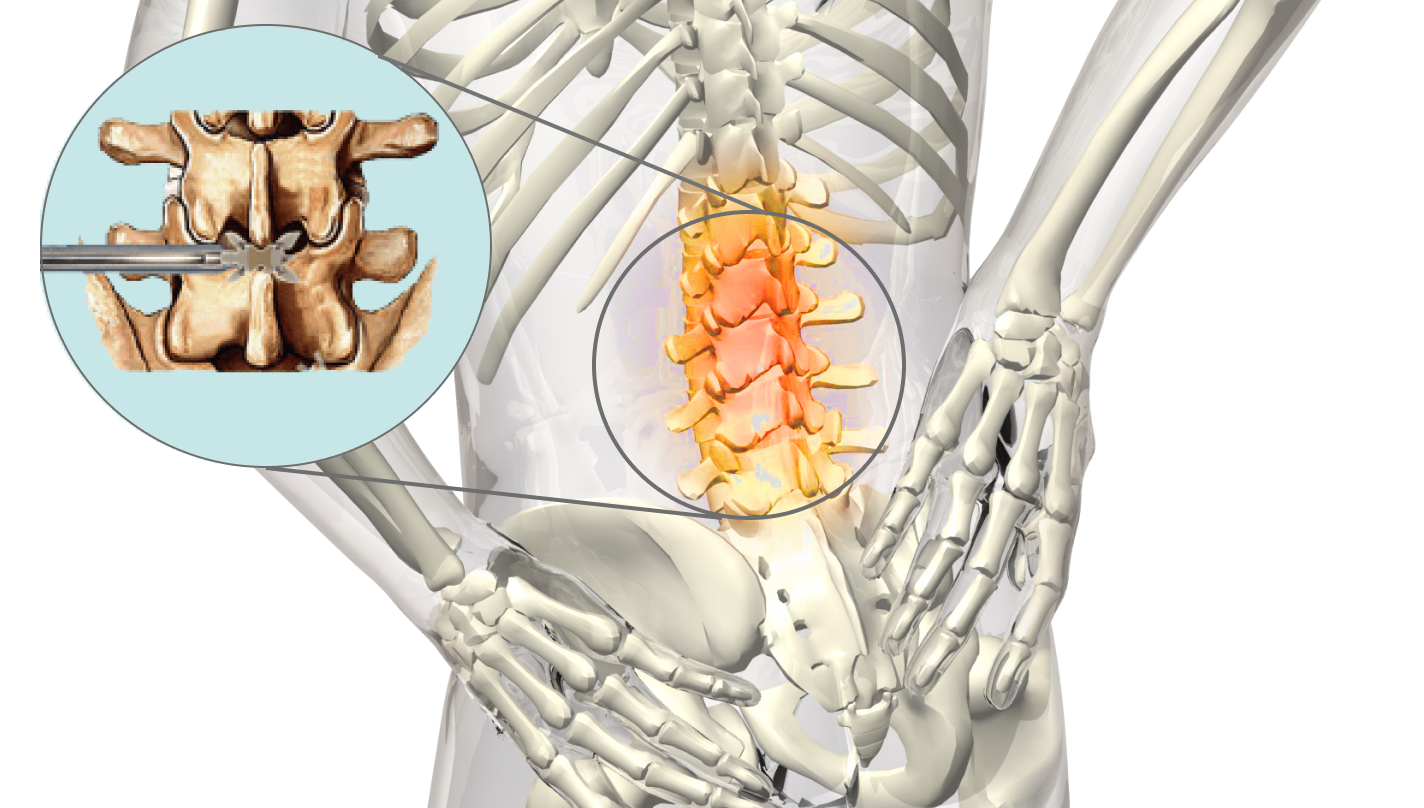
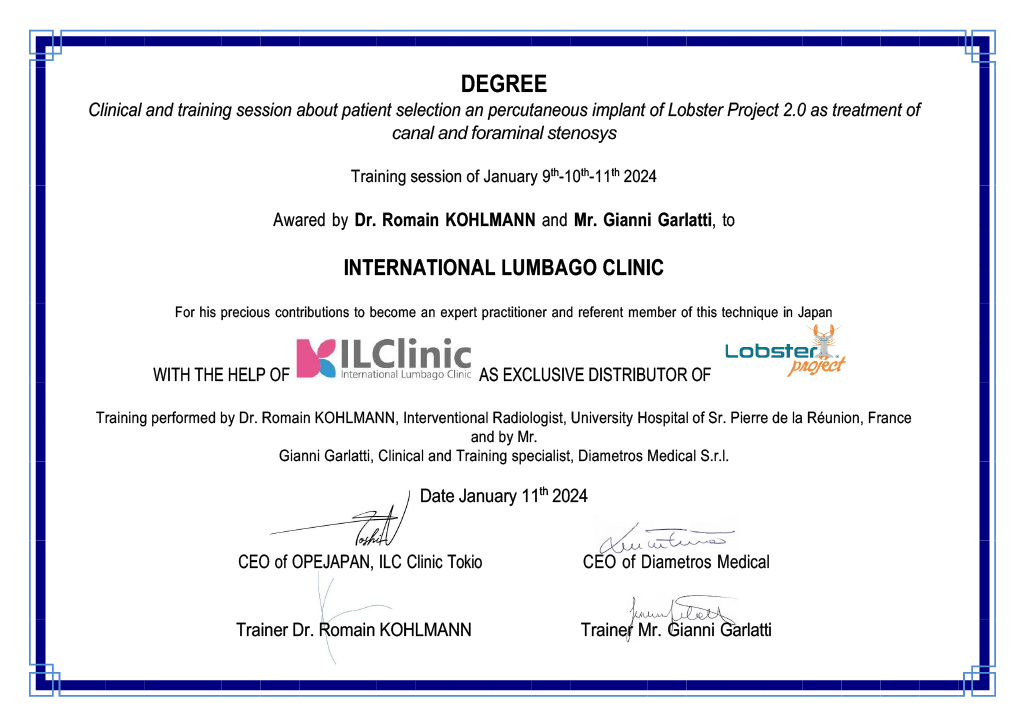
Florence Method Treatment
Under local anesthesia and using an X-ray fluoroscope, an incision of approximately 1 to 2 cm is made in the back, a special tube is placed between the spinous processes of the lumbar vertebrae to be treated, and a spacer is inserted.
The wings of the spacer are opened to widen the narrowed spinal canal.
Local anesthesia is used to minimize the burden on the body, leaving only a small scar, and after about 2 to 3 hours rest, you are allowed to go home, on the same day of treatment.

Characteristics of the Florence Method
- Treatment time is short, so it allows same-day treatment
- Since it is performed under local anesthesia, there is less burden on the body.
- Because it is a percutaneous procedure, the skin incision is small, there is no muscle damage, and there is no bone abrasion.
- It is possible to maintain the height of the intervertebral foramen and reduce the burden on the facet joints.
- Spacers are available in 6 sizes, allowing the doctors to insert a device that matches the patient's skeleton.
- It is also possible to remove the embedded spacer
Flow Treatment Flow
-
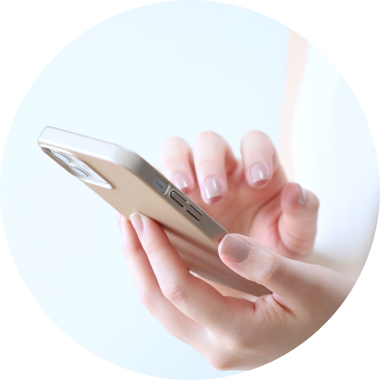
1. Inquiry
Our clinic is by appointment only, so be sure to make an appointment before visiting us.
Contact us on Whatsapp or by our contact form on this page.
-

2. Remote MRI Diagnosis
For Tokyo Clinic:
An MRI scan will be performed at a clinic affiliated with our clinic before your appointment at our clinic. Please send the MRI CD-ROM data to us via email prior to your visit. Also, if you have MRI images taken at another hospital, please let us know when you contact us.For Osaka Clinic:
The MRI scan will be performed at our clinic on the day of your appointment. -
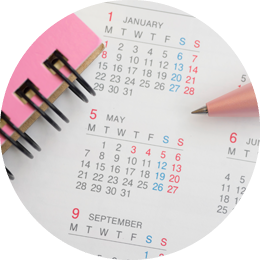
3. Choose Treatment Date
If the diagnosis confirms that you're a suitable candidate for our treatments, you may proceed to make an appointment with us. Kindly keep in mind the time it may take for you to secure a visa to enter Japan. A Japanese tourist visa is sufficient.
-
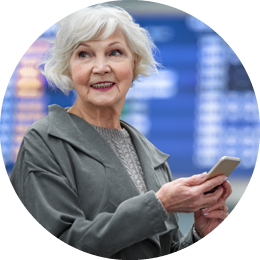
4. Travel Arrangements
As we are an outpatient facility, you will be discharged on the same day as your treatment. Patients are asked to take care of their own visas, travel and accommodation arrangements.
-
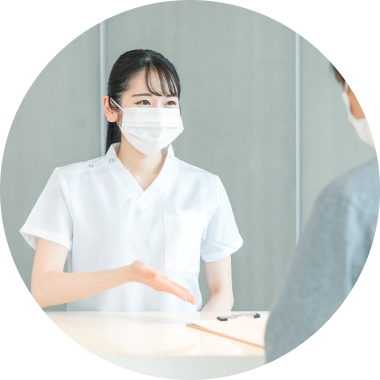
5. Pre-Treatment Examination
For Tokyo Clinic:
Please have your health insurance card, various medical certificates, image data, etc. ready when you come to the reception desk. After the check-in,, we will take X-ray images. After the X-ray, the doctor will spend approximately 30 minutes thoroughly examining the patient, and will consider and recommend the most suitable treatment plan for each patient.At the Osaka Clinic:
After the MRI/X-ray examination, the doctor will spend approximately 30 minutes thoroughly examining the patient, and will consider and propose the most appropriate treatment plan for each patient. -
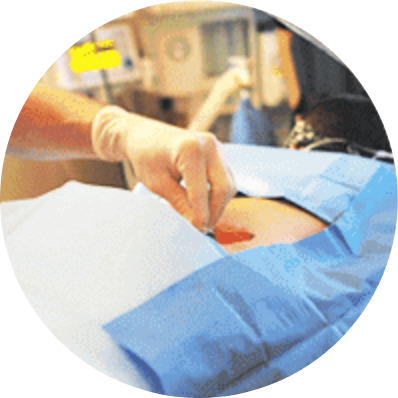
6. Treatment
The Florence method is currently only performed at the Osaka clinic.
After your consultation at each clinic, if you wish to receive treatment, please coordinate the treatment date and time with the staff.
On the day of your treatment, since you have already been examined, so we will begin your treatment immediately after you change your clothes and prepare. Treatment time is approximately 30 minutes per area. -
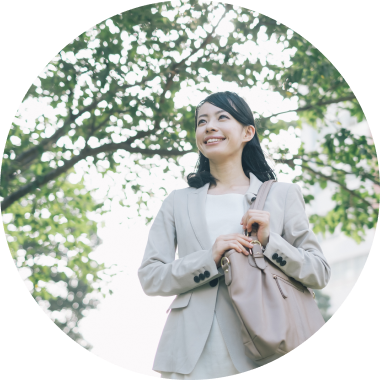
7. Discharge
After the treatment, we provide a recovery room for you to rest for about an hour to 1.5 hours.
You are free to return home after the doctor examines you. -

8. Follow-up
We will contact you regularly for follow-ups after your treatment.
If you have any questions, please feel free to contact us.
Price Costs of the Florence Method
| Number of Discs Treated | 1 disc | 2 discs |
|---|---|---|
| Treatment Cost | 1,540,000 JPY | 2,090,000 JPY |
* The cost of treatment is indicated including taxes.
*If treatment is performed at our clinic, all examination/diagnosis costs and test costs such as MRI are included in the above costs.
*This treatment method is not covered by Japanese health insurance, so you will have to pay for the entire treatment yourself.
*Payment by credit card (VISA, MasterCard, JCB, American Express, Diners, Discover) is also possible.
*If you would like rehabilitation (low back pain specialized rehabilitation), it is also possible to pay by bank transfer.
*If you live and work in Japan, you can receive a tax refund by filing your final medical expense return.
FAQ Q&A Regarding our clinic's treatment methods and spinal stenosis
-
QWhat's the difference in the reccurence rate between Cellgel and conventional surgery?
-
A
Surgical procedures, which began in the 1960s, aimed to remove and sometimes fix deformed bones and herniated tissue. However, new bone damage caused by screws and the lack of fundamental treatment (repair of the intervertebral disc annulus fibrosus) resulted in the appearance of additional back pain and recurrence rates.
Therefore, in the 1980s, the need for fundamental treatment increased, and the intervertebral disc treatment (Cellgel) that we provide at our clinic began. Cellgel, in particular, have been proven to repair and regenerate the intervertebral disc, resulting in not only improvement of symptoms, but also an extremely low recurrence rate.
-
QHow is the disc to be treated determined?
-
AThe doctor will spend about 30 minutes with the patient while looking at the MRI and X-ray images to determine the cause of the condition, determine the treatment area, and explain the corresponding treatment method to the patient. MRI images show the main factors that contribute to back pain (disc, nerve, ligament, and joint), such as changes in shape, pressure on the nerve, presence or absence of damage, and inflammation. The x-ray image mainly confirms the condition of the bones.
-
QWhy is the Cellgel method applicable to cases where surgery showed no improvement?
-
ADuring surgery for disc herniation, the prolapsed herniation is removed, but the damaged disc remains intact. As a result, fresh nucleus pulposus components leak from the damaged disc and inflammation persists. On the other hand, our treatment can treat the disc injury itself, thus suppressing inflammation by reducing the fresh leakage of nucleus pulposus components.
-
QMy back pain may temporarily worsen after treatment. How long will it last?
-
AThe reason for the lower back pain is that spinal ligaments that have been compressed are stretched; the lower back pain lasts for about two weeks and then subsides.
-
QWhat level of exercise can I perform after treatment?
-
AGeneral recreational exercise and sports can be done without any problem. For professional athletes, the possibility of new disc damage is high and should be discussed in consultation with a doctor.
-
QPlease tell me about what I should be cautious about after treatment.
-
ADuring the first few days after treatment, the patient should rest and avoid prolonged sitting, heavy lifting, twisting, bending, or strenuous exercise. Patients should be able to perform routine tasks one week after treatment and should be able to perform light exercise by the second week. Weight training is allowed after 3 months.
-
QIs the treatment covered by the Japanese national health insurance?
-
ANo, it is not covered by the national insurance. If you have life insurance, you may be eligible. Please feel free to consult our staff regarding this matter.
-
QHow long must I wait to be able to walk after treatment?
-
AIt is an outpatient/day treatment, so you can walk about an hour after the surgery.
-
QHow many doctor visits do I need to make before treatment?
-
AWe require an MRI to be taken within three months for remote diagnosis, either with our affiliated clinic or from data sent by you. You can receive treatment on the same day after phyiscal diagnosis. You may also request only the diagnosis and come back only for the treatment at a later date.
-
QCan I fly immediately after the treatment?
-
AIf there are no problems after the treatment, you may fly. If there is any pain after the treatment, flying may not be recommended depending on the doctor's evaluation.
-
QWhat are the symptoms to indicate I need surgery if I have spinal stenosis?
-
ASurgery may be recommended when there are hindrances in daily life such as difficulty in walking or urinating, or when the pain and numbness are severe and unbearable.
-
QI have been diagnosed with spinal stenosis. Do I have to undergo surgery?
Will it heal naturally if you leave it alone without surgery? -
AIt is unlikely to recover naturally. In addition, as surgery is one of many options, it is most important to consult with your doctor to get his/her opinion on the best treatment option. In some cases, exercise therapy or drug therapy may be an alternative to surgery.
-
QIf I leave my spinal stenosis untreated, will I be unable to walk in the future?
-
ADepending on the patient's symptoms and condition; in severe cases, they may be unable to walk.
-
QAre there alternative treatments for spinal stenosis (apart from those offered at the clinic)?
-
ASurgery. Spinal fusion or endoscopic surgery is used to stabilize the lower back by shaving down bones and discs, then fixing them in place.
-
QWhat about conservative treatment (medication/physical therapy/injections)? Will that cure spinal stenosis?
-
AThere is no complete cure. Conservative treatment intended to relieve pain and numbness and is not a fundamental treatment. The Cellgel method is the only treatment that can repair the disc that is causing the pain and therefore is expected to fundamentally improve the pain.
-
QWhat is the difference between vertebral stenosis and disc herniation?
-
AA herniated disc refers to a disc compressing a nerve, while spinal canal stenosis refers to a narrowing of the spinal canal. Spinal canal stenosis occurs when a herniated disc progresses and narrows the spinal canal, the nerve pathway in the spine.
-
QI was diagnosed with spinal canal stenosis and underwent spinal fusion surgery, but the pain has not gone away.
Can I be treated with the Cellgel method? -
AWe can provide treatment even after spinal fusion surgery, although we will need to diagnose your condition first.
Please contact us for a consultation.
-
QI have been diagnosed with spinal stenosis. Are there any other treatment options besides surgery?
-
AIn addition to surgery, there are other treatment methods such as drug therapy, heat therapy, and physical therapy (rehabilitation, etc.). ILC International Lumbago Clinic offers one-day disc treatment using needles without the need for incisions. The Cellgel method and other disc treatments that are less stressful on the body are proposed as an alternative to conventional surgical procedures.
-
QWhat is the difference between lumbar spondylolisthesis and spinal stenosis?
-
ALumbar spondylolisthesis refers to a deformation of the intervertebral disc that causes the disc to fail to maintain its shape and slip forward, compressing the nerve behind it and causing pain.
Spinal stenosis is a deformity and instability of the spine itself that causes inflammation around the nerves and compression of the spinal canal, which is the pathway for the nerves from the back and sides.
-
QRegarding the difference in recurrence rate between the Florence method and surgery
-
ACommon surgical operations for spinal canal stenosis include laminectomy and spinal fusion, but it has been reported that severe back pain may recur within 10 years after surgery, the patient may be unable to walk long distances, or they may need another operation. This is because the surgical procedure carries a high risk of damage to surrounding tissues such as ligaments and muscles, as well as new damage to bones caused by the screws. Therefore, the recurrence rate of symptoms is high after surgery.
On the other hand, the Florence method is performed with local anesthesia, which is less risky, and because it is a percutaneous procedure that requires a skin incision of about 1 to 2 cm, there is no damage to ligaments or muscles, and the recurrence rate is extremely low.
-
QHow is it decided where to treat?
-
AThe doctor spends about 30 minutes carefully examining the patient while looking at MRI and X-ray images, determines the cause of the patient's condition, determines the treatment area, and explains the corresponding treatment method to the patient. MRI images can confirm changes in shape, pressure on nerves, presence of damage and inflammation, etc. of the intervertebral discs, nerves, ligaments, and joints, which are all mainly associated with low back pain. can. X-ray images can mainly be used to check the condition of bones.
-
QCan the Florence Method and Cellgel Methods be used together?
-
AYes, these two treatments can also be done at the same time. There is no problem in performing the Florence method after treatment with the Cellgel method.
-
QCan my symptoms temporarily worsen after treatment?
-
ANo, your symptoms will not worsen after treatment. Depending on the case, paresthesia in the lower limbs may improve immediately after treatment. However, for lower back pain, you may need to take pain medication after treatment.
-
QWhat level of exercise can I do after treatment?
-
AIf it is a hobby level of exercise or sports, it can be done without any problem.
-
QPlease tell me what to be careful of after treatment.
-
AAfter surgery, avoid lifting heavy objects and doing strenuous exercise that involves twisting, bending, or stooping. Light exercise will be possible in the second week. Weight training is possible after 3 months.
-
QIs it covered by insurance?
-
ANo, it is not covered by insurance. Please feel free to contact our staff.
-
QHow long and how far can I walk after surgery?
-
ABecause the treatment is outpatient only, you can walk home within 2 to 3 hours after the procedure.
-
QHow many clinic visits do I need before surgery?
-
AOne examination is required before the surgery date. At the first consultation, we will review the images together to confirm your current condition and decide which treatment method is best for you. If the Florence method is optimal, you will be scheduled for surgery on another day.
-
QAre there any restrictions on my means of transportation after surgery?
-
AIt is best to refrain from using public transportation for 3 days after treatment. From the third day onwards, you may only travel by train or plane if you are accompanied by a companion.
ILC Rehabilitation X Spinal Stenosis Treatment
Although the Cellgel method can repair and regenerate the disc itself, and other treatment methods we offer can fundamentally heal the disc; it is possible that the cause of back pain is not only the disc, but also muscles, joints, and ligaments that are affected by the disc.
In cooperation with our rehabilitation specialists, we recommend treating back pain caused by muscles, joints, and ligaments together.
We also offer a short-term intensive program for patients who live far away or overseas.
-
ILC's Low Back Pain Treatment
Outpatient Treatment
Improve back pain disorders/
symptoms in relation to the nerves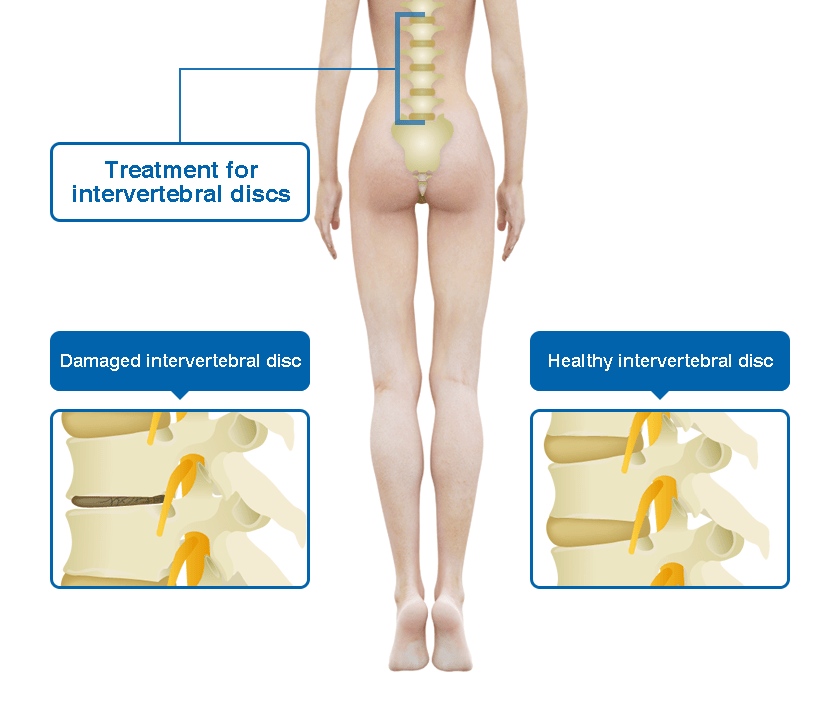
-
ILC's Rehabilitation Program
Specialized Low Back Pain Rehabilitation
Improve back pain disorders/symptoms in
relation to the joints, muscles, ligaments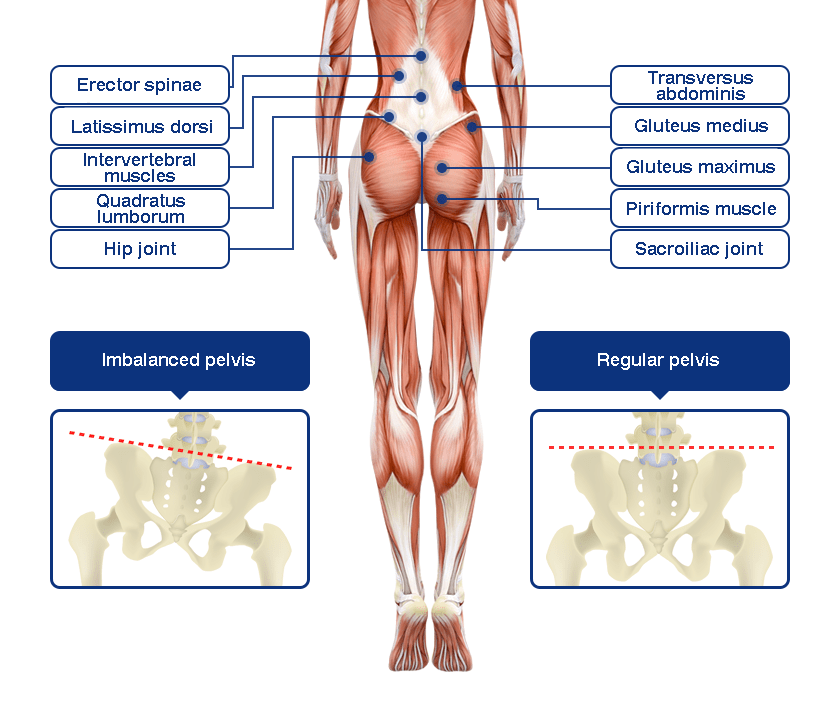
-
01
ILC's Specialized Back Pain Rehabilitation
Our Rehabilitation Approach to Spinal Stenosis
It is believed that the cause of symptoms of spinal stenosis is inflammation caused by physical irritation that spreads to the pain-sensitive areas of the nerves.
This physical irritation can be caused by protrusion of the nucleus pulposus due to disc degeneration or stress caused by abnormal posture or movement.For disc degeneration, repair using the Cellgel method is necessary.
On the other hand, inflammation caused by stress from abnormal posture or motion requires rehabilitation.
Hence, exercise therapy to alleviate physical stimuli and diet therapy to improve the body condition to alleviate inflammation at an early stage are paramount. -
02
ILC's Specialized Back Pain Rehabilitation
How to Evaluate Spinal Stenosis
The MRI imaging findings are evaluated before the physical examination to clarify the correlation between the image and physical motion. Based on the MRI analysis and doctor's examination, we can then confirm what kind of stenosis is occurring in which area of the spine.
Using the findings as a reference, we will evaluate the aggravating and mitigating factors of the symptoms in the posture and movements of daily life while actually moving the body slowly.
Aggravating factors are defined as movements that should not be performed, and mitigating factors are symptoms that can be alleviated by doing certain body movements. We will comphehensively evaluate these factors with muscle strength and stiffness, and explore the nature of the symptoms.
In addition, since inflammation is very closely related to the state of the physical body, we will also conduct a medical interview and evaluate the level of oxidative stress to evaluate the factors contributing to inflammation.
-
03
ILC's Specialized Back Pain Rehabilitation
Rehabilitation Treatment for Spinal Stenosis
There are three main types of spinal stenosis treatments:
-
Physical Therapy
To relieve the symptoms that cause spinal canal stenosis.
- Decompression (reduce nerve compression)
- i. Inner muscle activation → Increase intra-abdominal pressure and improve lumbar support between lumbar vertebrae by simultaneous contraction of the transversus abdominis and latissimus dorsi muscles
- ii. For lumbar kyphosis due to excessive contraction of back muscle groups → Stretching of back muscle groups and rehabilitation on all fours.
- iii. Training of rectus abdominis and oblique abdominis muscles → These muscles work in conjunction with deep abdominal muscles to support increased intra-abdominal pressure.
- Acupuncture improves blood flow obstruction and increases physiological recovery through temporary pain relief
- Decompression (reduce nerve compression)
-
Posture and Motion Improvement
To prevent inflammation caused by abnormal posture and movement.
- Correcting muscles and joints related to abnormal posture such as hunched back, etc.
- Improvement of blood flow obstruction and temporary pain relief through acupuncture to increase physiological recovery
- Increase in range of motion of the upper rib cage and flexibility of the glute muscles
-
Dietary Improvement
Provide dietary instructions tailored to the symptoms. For example:
- Antioxidant foods and fatty fish to improve blood flow and relieve stress.
- Intake of good quality "oil" to protect cell membranes of the brain and nerves and to build resillent bones.
In this way, we take into account the natural structure of the human body and remove the causes of the disease through daily habits. We hope these rehabilitation services help you lead a stress-free life.
-
Physical Therapy
-
04
ILC's Specialized Back Pain Rehabilitation
Treatment Period for Spinal Stenosis Rehabilitation
The length of treatment for spinal canal stenosis depends on the patient's symptoms and the degree of stenosis.
The nerves damaged by stenosis take time to recover, so patients need to be monitored for six months to a year.In general, the compression of the cauda equina nerve is difficult to remedy, and there is a high probability that the symptoms will remain severe. In the case of nerve root compression, the pain tends to subside relatively easily with rehabilitation.
Early detection and treatment of spinal canal stenosis is said to lead to better results. Therefore, we recommend that you visit a hospital as soon as symptoms appear.
We aim to achieve 100% effectiveness of treatment while incorporating the latest technology, so we spend at least 30 minutes with each patient to carefully and meticulously examine the patient's concerns in order to make a proper diagnosis and propose the most suitable treatment methods.
We are certain to find a way to alleviate or eliminate the pain and numbness you are experiencing, so please do not give up and give us a call instead!
- Tadaaki Minowa, Clinic Director
